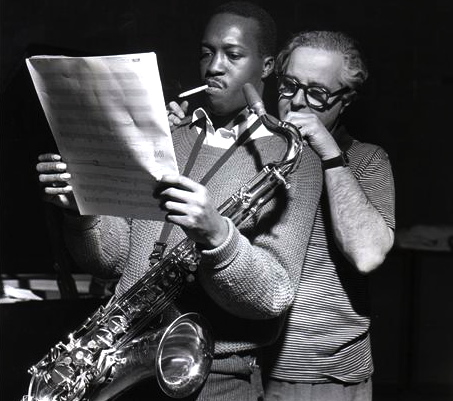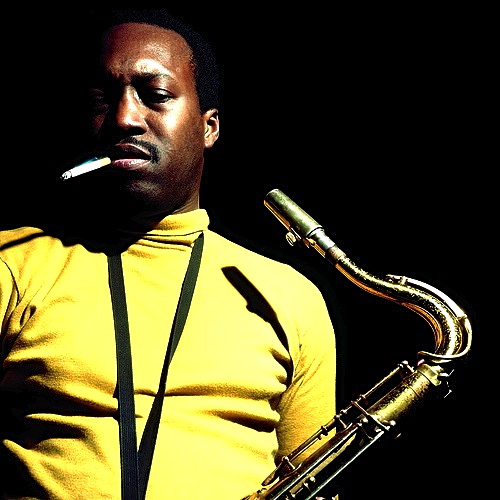
Henry (Hank) Mobley (tenor saxophone) was born July 7, 1930 in Eastman Georgia and passed away on May 30, 1986 in New York City.
Mobley was born in Eastman, Georgia, but was raised in Elizabeth, New Jersey, near Newark. There was plenty of music in his family, particularly piano music. When he was 16, an illness kept him in the house for several months, so his uncle thought of buying him a tenor saxophone to help him occupy his time. It was then that Mobley began to play saxophone.Hank tried to enter a music school in Newark, but wasn’t accepted since he wasn’t a resident, so he kept studying through books at home and basically taught himself the horn.
At age 19, he was hired by Paul Gayten and began working the rhythm and blues circuit with him between 1949 and ’51, having been recommended by Clifford Brown (who had not heard Mobley play at the time but was aware of his growing reputation). “Hank was beautiful, he played alto, tenor and baritone and did a lot of the writing,” Gayten recalled. “He took care of business and I could leave things up to him.”
Later on in 1951, Hank joined the house band at a Newark nightclub, where he played with pianist Walter Davis, Jr. and backed some of the era’s top jazz stars. That led to a job with Max Roach, who hired both Mobley and Davis after performing with them; they all recorded together in early 1953, at one of the earliest sessions to feature Roach as a leader. Meanwhile, Mobley continued to gig around his home area, playing with the likes of Milt Jackson, Tadd Dameron, and J.J. Johnson, among others; he also served two weeks in Duke Ellington’s orchestra in 1953.
Mobley spent much of 1954 performing and recording with Dizzy Gillespie. He left in September to join pianist Horace Silver’s group, which evolved into a quintet co-led by Art Blakey and dubbed the Jazz Messengers. Their groundbreaking first album for Blue Note, 1955′s Horace Silver and the Jazz Messengers, was a landmark in the genesis of hard bop, with its sophisticated solos and bright, almost funky rhythms.

Mobley led his first session for Blue Note, The Hank Mobley Quartet, in 1955, and recorded for Savoy and Prestige during 1956. In the middle of that year, the original lineup of the Jazz Messengers split, with Blakey keeping the name and Silver forming a new group. Mobley stayed with Silver until 1957, by which time he had begun to record prolifically as a leader for Blue Note, completing eight albums’ worth of material over the next 16 months.
Some of his best work, such as Hank Mobley and His All Stars and The Hank Mobley Quintet, was cut with a selection of old Messengers mates. Not all of his sessions were released at the time, but some began to appear as import reissues in the ’80s. Often composing his own material, Mobley was beginning to truly hit his stride with 1958′s Peckin’ Time, when a worsening drug problem resulted in an arrest that took him off the scene for a year. Upon returning to music in 1959, Mobley oriented himself by rejoining Art Blakey in the Jazz Messengers for a short period.
During the 1960s, he worked chiefly as a leader, recording over 20 albums for Blue Note Records between 1955 and 1970, including Soul Station (1960), generally considered to be his finest recording, and Roll Call (1960). He performed with many of the other important hard bop players, such as Grant Green, Freddie Hubbard, Sonny Clark, Wynton Kelly and Philly Joe Jones, and formed a particularly productive partnership with trumpeter Lee Morgan.
In 1961, Mobley caught what looked to be a major break when he was hired to replace John Coltrane in Miles Davis’ quintet. He is heard on the album Someday My Prince Will Come, alongside Coltrane, who returned for the recording of two tracks, and some live recordings, “In Person: Live at the Blackhawk and At Carnegie Hall.” Unfortunately, the association was a stormy one; Mobley came under heavy criticism from the bandleader, and wound up leaving in 1962. He returned to solo recording with 1963′s No Room for Squares, often tabbed as one of his best efforts, before drug and legal problems again put him out of commission during 1964.

Energized and focused upon his return, Mobley recorded extensively during 1965, showcasing a slightly harder-edged tone and an acumen for tricky, modal-flavored originals that challenged his sidemen. At the same time, Dippin’ found a funkier soul-jazz sound starting to creep into his work, an approach that reached its apex on the infectious A Caddy for Daddy later that year.
Mobley recorded steadily for Blue Note through the ’60s, offering slight variations on his approach, and continued to appear as a sideman on a generous number of the label’s other releases (especially frequent collaborator Lee Morgan). 1966′s A Slice of the Top found Mobley fronting a slightly larger band arranged by Duke Pearson, though it went unissued until 1979. After cutting the straightforward Third Season in 1967, Mobley embarked on a brief tour of Europe, where he performed with Slide Hampton.
He returned to the U.S. to record the straight-ahead Far Away Lands and Hi Voltage that year, and tried his hand at commercially oriented jazz-funk on 1968′s Reach Out. Afterward, he took Hampton’s advice and returned to Europe, where he would remain for the next two years. 1969′s The Flip was recorded in Paris, and Mobley returned to the States to lead his final session for Blue Note, Thinking of Home, in 1970 (it wasn’t released until ten years later). He subsequently co-led a group with pianist Cedar Walton, which recorded the excellent Breakthrough in 1972.
Sadly, that would prove to be Mobley’s last major effort. Health problems forced him to retire in 1975, when he settled in Philadelphia. He was barely able to even play his horn for fear of rupturing a lung; by the dawn of the ’80s, he was essentially an invalid. In 1986, he mustered up the energy to take two engagements at the Angry Squire in New York City in Nov. of ’85 and Jan. of ’86 in a quartet with Duke Jordan and guest singer Lodi Carr, unfortunately he passed away of pneumonia not long after, on May 30, 1986.
